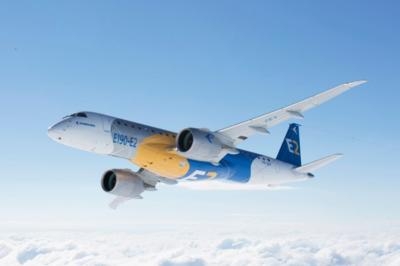Certification Comes Just 56 Months From Program Launch
In a ceremony held Wednesday at the Embraer's facilities in São José dos Campos, Embraer received Type Certificate for the E190-E2, the first member of the E-Jets E2 family of commercial aircraft, from the Brazilian Civil Aviation Agency (Agência Nacional de Aviação Civil – ANAC), the FAA and EASA. It is the first time that an aircraft program with the level of complexity of the E2 receives a type certificate from three major worldwide certification authorities simultaneously.

It took just 56 months from program launch until the E190-E2 was certified. The E190-E2 features new ultra-high bypass ratio engines and a completely new wing and landing gear. Compared to the first-generation E190, 75% of the aircraft systems are new.
"Having had the pleasure of launching the E-Jets E2 family back in 2013, it is very emotional for me to see the E190-E2 reach Type Certificate today, on schedule and on budget. Our development teams have once again excelled in their creativity, dedication and competence! Not only all development targets were met, but several important ones like fuel burn, performance, noise and maintenance costs came in better than originally specified," said Paulo Cesar de Souza e Silva, Embraer President & CEO. "I want to congratulate all the teams involved in the program, everyone at Embraer played a part in this tremendous achievement, bringing to the market the best and most efficient single-aisle aircraft in the world. The E190-E2, alongside with the Legacy 450, Legacy 500 and, soon, the KC-390, positions Embraer as one of the top aerospace companies in the world."
The flight test program comprised four prototype aircraft which were subjected to rigorous testing. The E190-E2 test fleet completed over 2,000 flight hours. Some 45,000 hours of tests were conducted in laboratories with rigs for aircraft avionics, flight controls, and electrical, hydraulic, and environmental systems.
"Certification of the E190-E2 marks a pivotal milestone in the program. It's reasonable to now anticipate an acceleration of commercial discussions with operators around the globe," said John Slattery, president & CEO, Embraer Commercial Aviation. "Today, many of the campaigns involving the E190-E2 and its bigger sibling the E195-E2 are with new operators for Embraer - and that's very encouraging as we continue our trajectory towards 100 E-Jets operators around the world."
Widerøe, the largest regional airline in Scandinavia, is the first airline in the world to receive the brand-new E190-E2 and will put the aircraft in revenue service in April. The airline has a contract for up to 15 E2 family jets consisting of three firm orders for the E190-E2 and purchase rights for 12 further E2 family aircraft.
Embraer recently announced some final flight test results confirming the E2 as the most efficient single-aisle aircraft on the market. In fuel consumption, the E190-E2 proved to be 1.3% better than originally expected, a 17.3% improvement compared to the current- generation E190.
The E190-E2 also becomes the most environmentally friendly aircraft in its class, with the lowest levels of external noise and emissions. Flight test results also confirmed the E190-E2 to be better than its original specification in takeoff performance. The aircraft's range from airports with hot-and-high conditions, such as Denver and Mexico City, increases by 600 nm compared to current-generation aircraft. Its range from airports with short runways, such as London City, also increases by more than 1,000 nm allowing the aircraft to reach destinations like Moscow and cities in the north of Africa.
The E190-E2 will also have the longest maintenance intervals among single-aisle aircraft with 10,000 flight hours for basic checks and no calendar limit for typical utilization. This means an additional 15 days of aircraft utilization over ten years compared to current generation E-Jets. Another key gain is with pilot transition training time. Pilots of current-generation E-Jets will need only 2.5 days of training and no full flight simulator to be qualified to fly an E2.
(Source: Embraer news release. Image from file)
 Airborne-Flight Training 05.09.24: ERAU at AIAA, LIFT Diamond Buy, Epic A&P
Airborne-Flight Training 05.09.24: ERAU at AIAA, LIFT Diamond Buy, Epic A&P ANN's Daily Aero-Term (05.07.24): Hazardous Weather Information
ANN's Daily Aero-Term (05.07.24): Hazardous Weather Information Aero-News: Quote of the Day (05.07.24)
Aero-News: Quote of the Day (05.07.24) NTSB Final Report: Cessna 150
NTSB Final Report: Cessna 150 Aero-News: Quote of the Day (05.08.24)
Aero-News: Quote of the Day (05.08.24)



